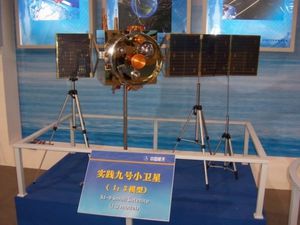Shijian-9 satellite
October 20, 2012 China Military News
2012-10-20 — (China Military News by China-defense-mashup)October 14, the Long March-2C rocket successfully sent Shijian-9 A/B satellites into orbit. And Chinese first new technology test satellite was successfully launched. Shijian-9 A/B satellites is developed by China SpaceEAST Co., Ltd under China Academy of Space Technology(CAST), subordinated to China Aerospace Science and Technology Corporation(CASC). The chief architect of the satellite is Zhao Zhiming.
According to Zhao Zhiming, the Shijian-9 project has a total of 25 technologies trials, each technology is critical for the future development of China’s satellite. In general terms, those technologies are divided into four categories, namely, long life and high reliability technology test, high-precision and high-performance technology test, the domestic component outer-space test and on-orbit formation flight technology.
Shijian-9 A/B satellite-complex uses tandem structure arrangement, and with the upper stage together looks like a bunch of “candied fruit”. In this launch, Long March-2C rocket has a very special rocket upper stage. First, the upper stage reached the orbit and then was adjusted to another attitude to release A-Star, and then throw away the A-star bracket, and then adjust the other direction to release B-star.
As the A and B two satellites are to conduct the formation flight tests, it is a high demands in upper stage’s releasing angle and attitude. Neither too close to the collision, nor be too far to lose contact. Meanwhile, the flight speed of orbiting objects about seven kilometers per second, throwing away the satellite bracket which is too close from the satellite will bring the risk of collision. So when the upper stage release the bracket it has to purposely changed at an angle. Those actions require that the upper stage can be flexible to meet the complex conditions.
From the Rockets ignition to the satellite separated from the rocket, it costs about 3300 seconds, which is longest working time of China’s Long March series of launch vehicles. And the upper stage vehicle has to independently work for more than 2700 seconds. The complexity of upper stage can be imagined.
It is precisely because of the complexity of the upper stage, which involves several Chinese space tech giants. The attitude control system is developed by the China Aerospace Science and Technology Corporation No. 801 Research Institute, the solid rocket engine developed by the China Aerospace Science and Industry Corporation No. 6 Research Academy and the inertia system by the China Aerospace Science and Technology Corporation’s No. 13 Research Institute.
Shijian-9′s design of the twin-satellite is partly because of sharing testing missions. On the other hand, two satellites will work together to verify the key technologies in-orbit formation flight. In simple terms, in-orbit formation flight is that two satellites in space transferred to the other location information and then follow the strict geometric relationships flight. This technology will be mainly used in three-dimensional earth observation areas to improve remote-sensing observation precision, providing surface elevation information of the target at the same time. This technology has a very wide range of military and civilian space-based remote sensing applications.
In China’s previous geosynchronous orbit satellites, more than half weight of satellite accounts for the the propellant for north-south pole position maintaining. It severely restricted the satellite payload and life. This time Shijian-9 will carry the experimental verification of the electric propulsion system to reduced to one-tenth of the original propellant weight, which can significantly improve the performance of the satellite. Now, China has multiple geosynchronous satellites in demonstration development to use the electric propulsion system, which is the urgent need of technical validation results of Shijian-9 project.
In addition, on some of the key components of China’s satellite still depend on importation. Shijian-9 A/B satellite mission will verify a number of much-needed domestic components in orbit performance, to accelerate domestic supply chain construction.
For example, Shijian-9B satellite’s core control computer is “SoC2008″ chip, independently developed by No. 502 Institute of under China Academy of Space Technology(CAST), has completely independent intellectual property rights. This indicates that China has made a breakthrough and master the SoC system level design, anti-radiation enhance design, fault-tolerant design, highly reliable real-time operating system design and other key technologies to occupy leading position in the world.
A system on a chip or system on chip (SoC or SOC) is an integrated circuit (IC) that integrates all components of a computer or other electronic system into a single chip. It may contain digital, analog, mixed-signal, and often radio-frequency functions—all on a single chip substrate. A typical application is in the area of embedded systems. SoC technology is the inevitable outcome of the development of microelectronic technology to an advanced stage.
With SoC technology, Chinese aerospace platform is no longer in a situation of continued requirement on foreign chips, but to base on domestic design, production and technological level, and to determine the more reasonable aerospace electronics technology, system architecture, and performance specifications, and make the progressive realization of the high-end chip production’s localization. SoC technology is the key strategic technology to realize core components independence.
SoC2008 is a high-performance SOC chip oriented for aerospace electronic systems, with low-power and anti-radiation enhancement. It can meet the application needs of all kinds of spaceborne electronic systems. SoC2008 overall performance is equal with products launched in Europe in 2010, reached the international advanced level in the same period. SoC2008 has been applied in CAST100 series small satellite platform’s control computer, long-life star sensor control computer, satellite landing central control unit, space station robotic arm subsystem controller and cargo spacecraft GNC subsystems guidance.





